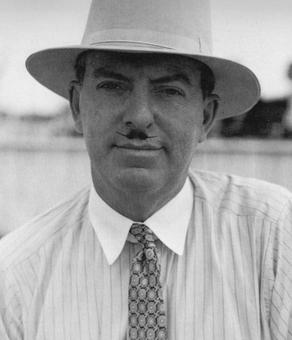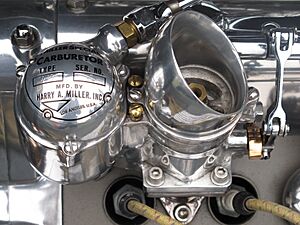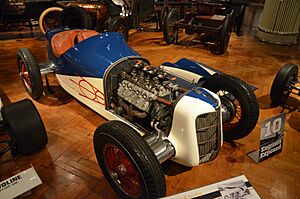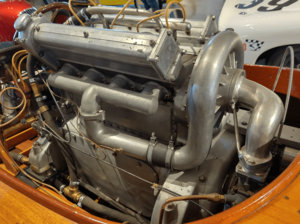Harry Miller (auto racing) facts for kids
Quick facts for kids
Harold Arminius Miller
|
|
|---|---|

Miller in 1932
|
|
| Born | December 9, 1875 |
| Died | May 3, 1943 (aged 67) |
| Spouse(s) | Edna Inez Lewis |
Harold Arminius Miller (December 9, 1875 – May 3, 1943), often called Harry, was an American race car designer and builder. He was most active in the 1920s and 1930s.
Many people say he was the most creative person in the history of American racing cars. Cars built by Miller won the famous Indianapolis 500 race nine times. Other cars using his powerful engines won three more times. His cars were a huge part of the Indy 500 races between 1923 and 1928.
Contents
Early Life and Career
Miller was born on December 9, 1875, in Menomonie, Wisconsin. His first job in the car world was with the Yale Automobile Company. After that, he moved to Lansing, Michigan. There, he worked for Ransom E. Olds at Oldsmobile. He was a race mechanic during the early Vanderbilt Cup races. After the 1906 racing season, Miller moved to Los Angeles, California. He opened a small shop that made carburetors. Carburetors are important parts that mix fuel and air for an engine.
Miller's Amazing Inventions
Miller created many new things. He might have built the first engine mounted on a bicycle. He also built a 4-cylinder engine and put it on a boat. His neighbor, Ole Evinrude, later used a similar idea to patent the first outboard motor.
Miller also made the first pistons out of aluminum. He even helped create the aluminum alloys that are still used in engines today. He also designed carburetors and air intake systems that used special sound chambers called Helmholtz resonators.
Building Race Cars
Miller's work with carburetors led him to repair and then build race cars. By the 1910s, he was making a lot of money from selling his carburetors. In the early 1920s, he built his own 3.0-liter engine. He got ideas from other engine designs he had worked on. This engine had 4 cylinders, special overhead camshafts, and 4 valves per cylinder.
A racing driver named Tommy Milton helped pay to make this engine. But it was Jimmy Murphy who first won with it. Murphy's Duesenberg car, powered by Miller's engine, won the 1922 Indianapolis 500.
Miller then started building his own Miller single-seater race cars. These cars used supercharged versions of his smaller 2.0 and 1.5-liter engines. These engines helped win the Indy 500 four more times up to 1929. Two of those wins (1926 and 1928) were in Miller-built cars. His engines won the race seven more times between 1929 and 1938. Two of those wins (1930 and 1932) were also in Miller cars.
In the 1920s and 1930s, Miller's engines also powered speedboats. These boats won many races and set world water speed records. One famous person who won with his engines on the water was Gar Wood.
Later Years and Legacy
Miller faced financial problems and declared bankruptcy in 1933. His shop foreman, Fred Offenhauser, bought the business. Fred continued to develop Miller's engine designs. These engines became known as Offenhauser engines. They were very successful in racing until the 1980s.
After his bankruptcy, Miller worked with Preston Tucker, who loved the Indianapolis 500 race. In 1935, they started a company called Miller and Tucker, Inc. Their first big job was to build ten special Ford V-8 race cars for Henry Ford. These cars had some problems at first because they were built too quickly. But later, private teams fixed the design. These cars raced at Indianapolis until 1948.
Miller and Tucker, Inc., moved to Indianapolis. They kept working on new race car designs. In the late 1930s, Miller and Tucker also created the Tucker Combat Car. They tried to sell it to the Dutch and U.S. governments. This car could go 115 mph (185 km/h) on roads. It could also go 65 mph (105 km/h) on rough ground. It had cool new features, like a gun turret that moved with power. The U.S. government bought the gun turret design. It was used on planes like the B-17 and B-29. It was also used on PT boats and landing craft.
Miller used some ideas from the Tucker Combat Car for another project. He worked with American Bantam to help develop the first Jeep.
Tucker and Miller worked together until Miller's death in 1943. Tucker even helped Miller's wife pay for the funeral. While working with Miller, Tucker met John Eddie Offutt. Offutt later helped Tucker build the first prototype of the 1948 Tucker Sedan.
Miller died on May 3, 1943, in Detroit, Michigan, at 67 years old.
Awards and Recognition
- He was named to the National Sprint Car Hall of Fame in 1990.
- He was inducted into the Motorsports Hall of Fame of America in 1999.
- He was inducted into the Automotive Hall of Fame in 2003.
Tribute
Miller was honored at the 1993 Monterey Historic Automobile Races.
Images for kids








